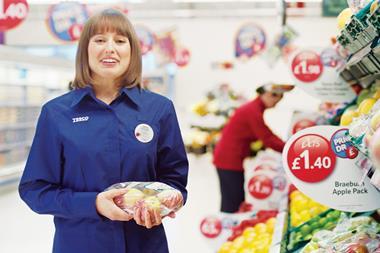The deals might shift off-the-shelf products, but how will the multiples move to the hi-tech end of the market, where consumers need specialist advice? Steve Hemsley reports
In November, American entertainment giant Disney announced it was entering the European consumer electronics market and that branded audio and visual products aimed at children would be available in the UK within months.
The arrival of Mickey Mouse and his friends, and the obvious marketing opportunities they will provide, can only help the grocers which are gradually increasing their involvement in the consumer electronics and electricals sector.
The low margins available on most electrical items have not deterred the supermarkets which remain confident they can shift the volumes they need to by using a deliberate policy of careful product selection and clever strategies for promotion.
A return of between 5% and 15% is the norm. Exclusive research for The Grocer from Information Resources shows grocers generated sales of over £755m from electricals in the year to November 2003. Verdict Research says supermarkets have a 2.9% marketshare and this is predicted to rise to 4.8% (£1.4bn) by 2007, making it one of the fastest growing non-food sectors for grocery.
Indeed there has been plenty of activity. Asda has added household brand
names such as JVC and Sony this year, Morrisons has widened its electricals range in 100 stores and Tesco, which has introduced another 2,000 non-food lines in 2003, now stocks everything from wide-screen televisions to Dyson cleaners. The space given over to electrical products within the Co-operative Group’s food stores has increased by 15% in the past 18 months, and Safeway dedicates up to 10% of sales space in its superstores and megastores to electricals.
Televisions and toasters appear to be of less interest to Sainsbury’s customers, hence the category’s relatively low profile within its own non-food offer, which was expanded in September when 2,500 homeware and cookware products were introduced.
To generate the sales volumes the grocers demand, most electrical items are heavily promoted. The most popular strategy is the When It’s Gone It’s Gone (WIGIG) campaign where a deal is struck with a supplier to obtain a limited number of branded items.
Safeway will offer an average of five WIGIG deals involving electrical products every week in even its smallest stores. Aldi has also generated
significant sales using this particular marketing technique, and it has become a major player in the PC market in Germany as a result.
These promotions will shift product quickly, although there is always the risk a supermarket’s relationship with its customers will take a knock if someone is left disappointed when they arrive at their local store to find all the discounted products have been sold.
Ensuring good customer service in this particular non-food category remains a dilemma for the grocers. Verdict believes the grocers’ non-food offer overall is being let down by poor instore disciplines, inconsistent ranging and very limited dedicated staff.
With off-the-shelf domestic appliances such as kettles and vegetable steamers, product knowledge is rarely required, but as the supermarkets move into more technical product areas, such as sophisticated entertainment systems, there is pressure to offer advice on the different models displayed. The supermarkets do provide a product guarantee, usually for up to one year, and operate a ‘no questions asked’ returns policy.
“The problem grocers have is how to go beyond the products they stock at the moment and into the middle to top end of electricals and electronics where consumers need product guidance,” says Steve Gotham, senior analyst at Verdict.
Mike Godliman, director at Pragma Consulting, says it was inevitable the supermarkets would increase their involvement in this category after achieving considerable success selling DVD players. He says the supermarkets avoid being asked too many questions by their customers by offering a narrow but branded choice of models which consumers trust.
“But the multiples may need to provide a specific service desk if they want to win significantly more sales from the specialists, where staff do receive more specific training,” he says.
Yet so far the grocers have not been deterred from broadening their range. The success of audio and visual lines has even convinced the multiples to dip their toes into the large kitchen appliances market, selling freezers and dishwashers which are considered purchases and rarely bought on price alone. These items tend to be sold in only the largest stores or via the internet and grocery’s share of this market has grown from 0.2% in 1998 to 1.1% in 2002 [source: IMIS].
The supermarkets’ slice of the microwaves business is also growing, up from 0.8% to 2.7% over the same period, while their share of sales of smaller electrical appliances, such as electric toothbrushes, has increased at a slower rate to reach 1.0% (0.9%).
How and where electrical products are sourced is a vital consideration for such low margin items. Increasingly the supermarkets are searching for new and less well-known foreign brands, while the
leading manufacturers have discovered that the most cost-effective way of servicing the volumes UK retailers demand is to ship components to the UK and assemble models here before distribution.
This policy also means that grocers can negotiate exclusive models which may not include the same features as those available on the more expensive models sold through the specialists, and can therefore be priced more competitively.
Convenience and price are the obvious reasons why someone would choose to purchase a television or toaster from a supermarket rather than from a specialist, but the grocers are actually finding themselves serving a much broader consumer demographic than the traditional electrical retailer.
According to researcher Mintel, while out of town specialists tend to appeal to families, and high street outlets such as Dixons and Currys are particularly popular among males with full-time jobs, the supermarket shopper buying audio-visual goods is just as likely to be a man as a woman and to work part-time as full-time. Shoppers in the north of England are particularly keen to buy audio-visual products from a supermarket it seems.
“Our consumer knows what he or she wants. They are looking for value for money on a recognisable brand from a store they know and trust,” explains Jimmy Jones, category manager, electricals and homewares for the Co-operative Group which stocks brands such as Bush, Beko, Naiko and Goodmans as well as more well-known names such as Hoover, Candy, Hotpoint and Russell Hobbs.
The majority of grocery purchases are needs-led and repetitive purchases, but when it comes to non-food, and electricals in particular, consumers have other considerations when making their purchasing decisions.
If grocery is to continue to beat the specialists at their own game their point of sale message must be clear and instore advice must be available. This is one category where low prices and convenience will not always be enough.
In November, American entertainment giant Disney announced it was entering the European consumer electronics market and that branded audio and visual products aimed at children would be available in the UK within months.
The arrival of Mickey Mouse and his friends, and the obvious marketing opportunities they will provide, can only help the grocers which are gradually increasing their involvement in the consumer electronics and electricals sector.
The low margins available on most electrical items have not deterred the supermarkets which remain confident they can shift the volumes they need to by using a deliberate policy of careful product selection and clever strategies for promotion.
A return of between 5% and 15% is the norm. Exclusive research for The Grocer from Information Resources shows grocers generated sales of over £755m from electricals in the year to November 2003. Verdict Research says supermarkets have a 2.9% marketshare and this is predicted to rise to 4.8% (£1.4bn) by 2007, making it one of the fastest growing non-food sectors for grocery.
Indeed there has been plenty of activity. Asda has added household brand
names such as JVC and Sony this year, Morrisons has widened its electricals range in 100 stores and Tesco, which has introduced another 2,000 non-food lines in 2003, now stocks everything from wide-screen televisions to Dyson cleaners. The space given over to electrical products within the Co-operative Group’s food stores has increased by 15% in the past 18 months, and Safeway dedicates up to 10% of sales space in its superstores and megastores to electricals.
Televisions and toasters appear to be of less interest to Sainsbury’s customers, hence the category’s relatively low profile within its own non-food offer, which was expanded in September when 2,500 homeware and cookware products were introduced.
To generate the sales volumes the grocers demand, most electrical items are heavily promoted. The most popular strategy is the When It’s Gone It’s Gone (WIGIG) campaign where a deal is struck with a supplier to obtain a limited number of branded items.
Safeway will offer an average of five WIGIG deals involving electrical products every week in even its smallest stores. Aldi has also generated
significant sales using this particular marketing technique, and it has become a major player in the PC market in Germany as a result.
These promotions will shift product quickly, although there is always the risk a supermarket’s relationship with its customers will take a knock if someone is left disappointed when they arrive at their local store to find all the discounted products have been sold.
Ensuring good customer service in this particular non-food category remains a dilemma for the grocers. Verdict believes the grocers’ non-food offer overall is being let down by poor instore disciplines, inconsistent ranging and very limited dedicated staff.
With off-the-shelf domestic appliances such as kettles and vegetable steamers, product knowledge is rarely required, but as the supermarkets move into more technical product areas, such as sophisticated entertainment systems, there is pressure to offer advice on the different models displayed. The supermarkets do provide a product guarantee, usually for up to one year, and operate a ‘no questions asked’ returns policy.
“The problem grocers have is how to go beyond the products they stock at the moment and into the middle to top end of electricals and electronics where consumers need product guidance,” says Steve Gotham, senior analyst at Verdict.
Mike Godliman, director at Pragma Consulting, says it was inevitable the supermarkets would increase their involvement in this category after achieving considerable success selling DVD players. He says the supermarkets avoid being asked too many questions by their customers by offering a narrow but branded choice of models which consumers trust.
“But the multiples may need to provide a specific service desk if they want to win significantly more sales from the specialists, where staff do receive more specific training,” he says.
Yet so far the grocers have not been deterred from broadening their range. The success of audio and visual lines has even convinced the multiples to dip their toes into the large kitchen appliances market, selling freezers and dishwashers which are considered purchases and rarely bought on price alone. These items tend to be sold in only the largest stores or via the internet and grocery’s share of this market has grown from 0.2% in 1998 to 1.1% in 2002 [source: IMIS].
The supermarkets’ slice of the microwaves business is also growing, up from 0.8% to 2.7% over the same period, while their share of sales of smaller electrical appliances, such as electric toothbrushes, has increased at a slower rate to reach 1.0% (0.9%).
How and where electrical products are sourced is a vital consideration for such low margin items. Increasingly the supermarkets are searching for new and less well-known foreign brands, while the
leading manufacturers have discovered that the most cost-effective way of servicing the volumes UK retailers demand is to ship components to the UK and assemble models here before distribution.
This policy also means that grocers can negotiate exclusive models which may not include the same features as those available on the more expensive models sold through the specialists, and can therefore be priced more competitively.
Convenience and price are the obvious reasons why someone would choose to purchase a television or toaster from a supermarket rather than from a specialist, but the grocers are actually finding themselves serving a much broader consumer demographic than the traditional electrical retailer.
According to researcher Mintel, while out of town specialists tend to appeal to families, and high street outlets such as Dixons and Currys are particularly popular among males with full-time jobs, the supermarket shopper buying audio-visual goods is just as likely to be a man as a woman and to work part-time as full-time. Shoppers in the north of England are particularly keen to buy audio-visual products from a supermarket it seems.
“Our consumer knows what he or she wants. They are looking for value for money on a recognisable brand from a store they know and trust,” explains Jimmy Jones, category manager, electricals and homewares for the Co-operative Group which stocks brands such as Bush, Beko, Naiko and Goodmans as well as more well-known names such as Hoover, Candy, Hotpoint and Russell Hobbs.
The majority of grocery purchases are needs-led and repetitive purchases, but when it comes to non-food, and electricals in particular, consumers have other considerations when making their purchasing decisions.
If grocery is to continue to beat the specialists at their own game their point of sale message must be clear and instore advice must be available. This is one category where low prices and convenience will not always be enough.


















No comments yet